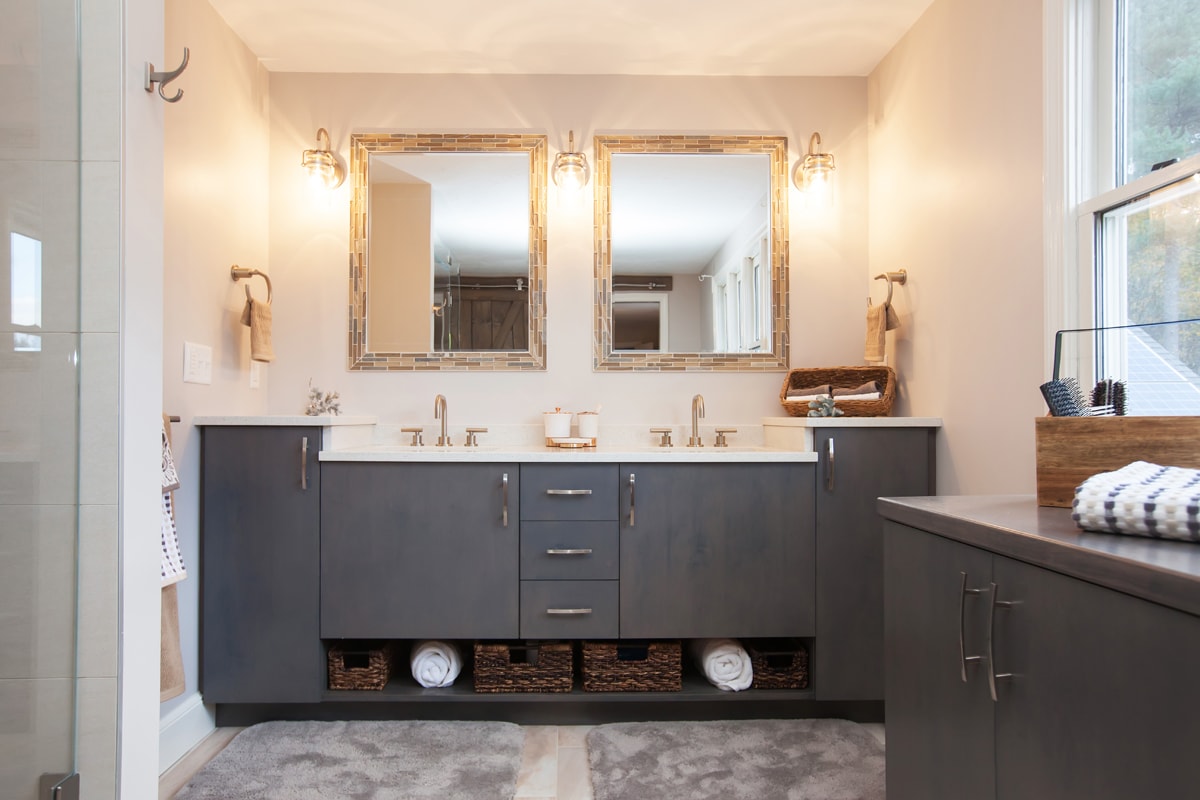Design Considerations

The design of a bathroom vanity between two walls requires careful consideration to ensure optimal functionality and aesthetic appeal. Factors such as available space, ergonomic principles, and personal preferences play a crucial role in determining the ideal dimensions, style, and materials.
For a bathroom vanity between two walls, consider the dimensions and layout of the space. In the realm of yacht interior design , vanities are often designed to complement the overall aesthetic, featuring sleek lines and luxurious materials. Similarly, in a bathroom between two walls, the vanity can serve as a focal point, adding a touch of elegance and functionality to the space.
When determining the optimal dimensions, it is important to consider the available space in the bathroom. The vanity should be wide enough to accommodate the necessary storage and countertop space, while leaving sufficient room for comfortable movement. Ergonomic principles should also be taken into account, ensuring that the height and depth of the vanity are suitable for the user’s height and reach.
A bathroom vanity between two walls can provide ample storage and counter space, making it a great choice for small bathrooms. When choosing a vanity, it’s important to consider the size, style, and finish. For a more unique look, consider exploring wholesale decor options.
These pieces are often one-of-a-kind and can add a touch of personality to your bathroom. With careful planning, a bathroom vanity between two walls can be a stylish and functional addition to your home.
Vanity Styles
Bathroom vanities come in a wide range of styles, each complementing different bathroom designs. Modern vanities often feature clean lines, sleek surfaces, and minimalist aesthetics. Traditional vanities, on the other hand, exude a classic charm with ornate details, curved edges, and rich finishes. Minimalist vanities prioritize simplicity and functionality, with a focus on hidden storage and understated design.
Material Selection
The choice of materials for the vanity should consider durability, water resistance, and aesthetic appeal. Solid wood vanities offer a timeless and elegant look, but require regular maintenance to prevent water damage. Engineered wood vanities, such as MDF or plywood, provide a more affordable option with good durability and water resistance. Laminate vanities are highly resistant to water and stains, making them a practical choice for busy bathrooms.
Functional Features
:max_bytes(150000):strip_icc()/double-vanity-ideas-1-erin-williamson-design-hill-country-lake-house-6857062a43964338b557315bacc7424f.jpg)
Incorporating functional features into a bathroom vanity between two walls enhances its usability and creates a more convenient and efficient space. Storage solutions, built-in lighting, electrical outlets, and well-chosen sink types contribute significantly to the vanity’s overall functionality.
Storage is crucial in a bathroom vanity, providing ample space for toiletries, towels, and other essentials. Drawers, cabinets, and open shelves offer varying levels of accessibility and organization. Drawers provide concealed storage, keeping items hidden from view, while cabinets with doors allow for larger items. Open shelves provide easy access to frequently used items but may accumulate dust and clutter.
Built-in Lighting
Built-in lighting is an essential functional feature, illuminating the vanity area for better visibility during grooming and makeup application. Overhead lighting can cast shadows, making it difficult to see clearly. Vanity mirrors with built-in lighting provide direct illumination, eliminating shadows and ensuring a well-lit workspace.
Electrical Outlets, Bathroom vanity between two walls
Electrical outlets are a must-have for powering electric toothbrushes, hair dryers, and other appliances. Integrating outlets into the vanity design allows for convenient access without the need for extension cords. Consider placing outlets on both sides of the vanity for easy reach.
Sink Types
The choice of sink type depends on personal preference and the overall design of the vanity. Vessel sinks rest on top of the vanity, creating a striking visual statement. Undermount sinks are installed beneath the countertop, providing a seamless look and easier cleaning. Drop-in sinks are partially recessed into the countertop, offering a compromise between vessel and undermount sinks.
Installation and Maintenance: Bathroom Vanity Between Two Walls

Installing and maintaining a bathroom vanity between two walls requires careful planning and execution to ensure a secure and functional setup. Proper care and maintenance techniques will extend the vanity’s lifespan and keep it looking its best.
Installation
Begin by ensuring that the space between the walls is level and plumb. Install the vanity base by securing it to the studs with screws. Level the base using a level and adjust the legs if necessary. Attach the vanity top to the base and secure it with screws or brackets. Connect the plumbing and electrical fixtures.
Maintenance
Clean the vanity regularly with a mild detergent and water. Seal the countertop and backsplash periodically to prevent stains and water damage. Repair minor damage, such as scratches or dents, promptly using appropriate materials and techniques.
Troubleshooting
- Leaks: Check for loose connections in the plumbing and tighten them. If the leak persists, contact a plumber.
- Loose Fixtures: Tighten any loose screws or bolts securing the fixtures to the vanity.
- Damaged Surfaces: Repair minor scratches or dents using a touch-up kit or by sanding and refinishing the surface.